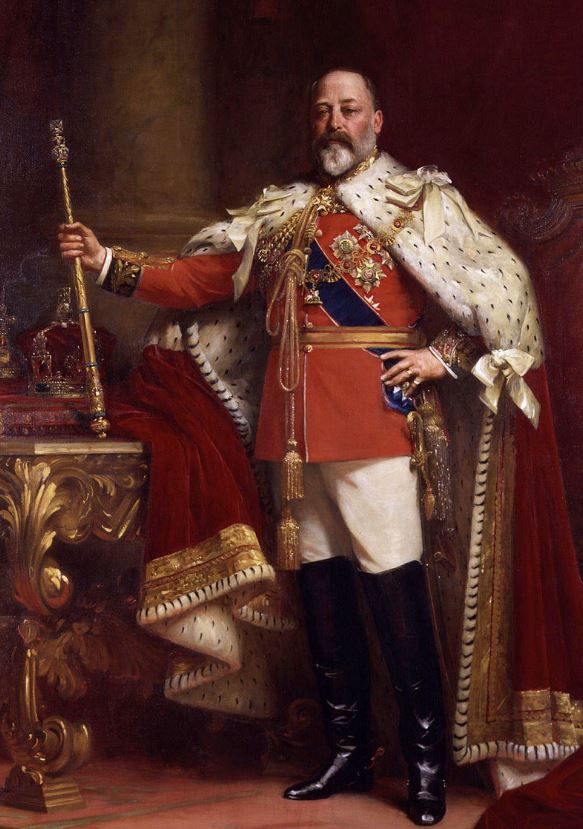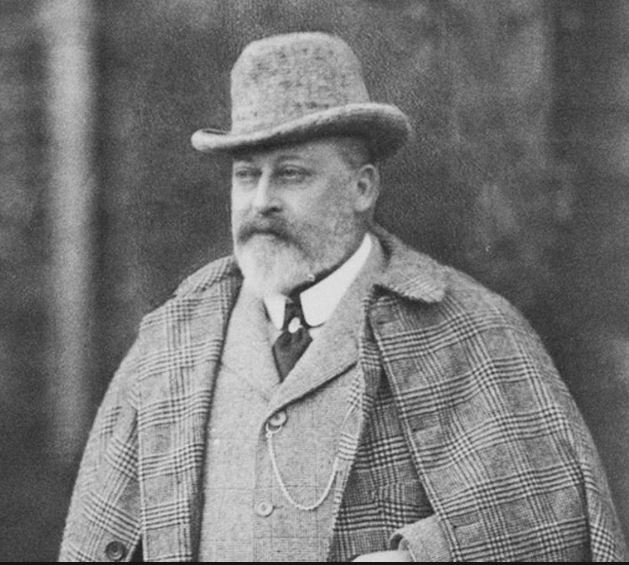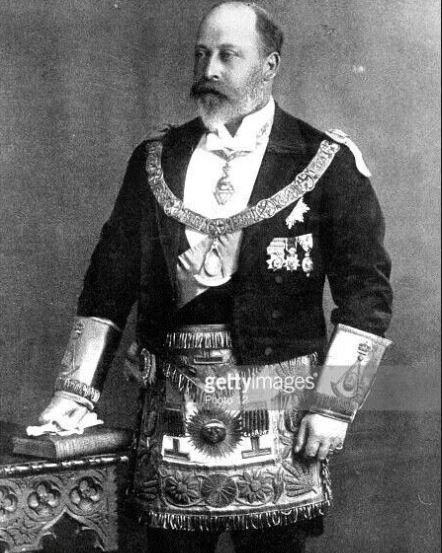
King Edward VII – King, Emperor of India, Freemason
1841-1910
Albert Edward, was named after his father, Prince Albert, later Prince Consort, and his grandfather, Edward, Duke of Kent. He was born on 9 November 1841, the eldest son of Queen Victoria and Prince Albert, and was christened in St. George’s Chapel, Windsor on 25 January 1842. He had 8 siblings – Victoria (1840), Alice (1843), Alfred (1844), Helena (1846), Louise (1848), Arthur (1850, Leopold (1853) and Beatrice (1857).
Just a year after his birth, he was created Prince of Wales and Earl of Chester on 8 December 1841. By virtue of his position as eldest son of the Sovereign, he was Duke of Cornwall and Duke of Rothesay. Further titles and honours followed – Prince of Saxe-Coburg and Gotha and Duke of Saxony, Earl of Dublin (10 September 1849), Knight of the Garter (9 November 1858) and Knight of the Thistle (24 May 1867). The Prince’s parents, especially his father, attempted to encourage him in educational development with short periods of study at Edinburgh, Oxford and Cambridge Universities.
On 10 March 1863, the Prince of Wales married Princess Alexandra of Denmark in St George’s Chapel, Windsor. The Prince was 21 at the time of his marriage and his wife was 18. The happiness of the occasion was marred by the sudden death of the Prince Consort in 1861, from which loss Queen Victoria never fully recovered. At this time, the Prince was also Heir Presumptive to the Duchy of Saxe-Coburg and Gotha, a title to his brother, Alfred.
The Prince and Princess of Wales had 6 children – Albert Victor, George, Maud, Victoria, Louise and Alexander John. Concern was expressed throughout the years leading up to the Prince succeeding his mother to the Throne about his lifestyle. In fact, in many ways, he confounded his critics. He played an important role in bringing about the Entente Cordiale between Britain and France. As a result of the network of relationships created through marriages et.al., the British Monarchy could lay claim to forging the great monarchical dynasties of Europe. As King, ‘Bertie’ as he was affectionately known was referred to as the ‘Uncle of Europe’.

Perhaps the affection, in which he was held, was responsible for the difficult relationship which he had with his nephew, the Kaiser. After his succession to the Throne, the new King was responsible for the reintroduction of many of the traditional cermonies and state occasions such as the State Opening of Parliament, from which his mother had withdrawn. Undoubtedly, in behavior, mannerisms, and dress he was flamboyant.
What then of the Prince of Wales’ and later King Edward VII’s Masonic CV.? On 20 December 1868 he was initiated in The Swedish Grand Master’s Lodge in the Royal Palace, Stockholm, by Charles XV, King of Sweden and Norway, assisted by his brother, Prince Oscar, taking the first 6 Degrees of the Swedish Rite and the remaining 4 of the 10 degrees being conferred on 21 December 1868 and also the 11th and Highest Degree is known as the Knight Commander of the Red Cross becoming a Knight Commander of the Royal Order of King Charles XII of Sweden.
On 1 September 1869, the Prince was elected as a Past Grand Master in the United Grand Lodge of England and invested and proclaimed on 1 December 1869. he became a member of a number of many Lodges in England – Royal Alpha Lodge No 16, Apollo University Lodge No 357, Prince of Wales Lodge No 259, Household Brigade Lodge No 2614, Navy Lodge No 2612, Sancta Maria Lodge No 2682, and Grand Master’s Lodge No 1.
In a number of these Lodges, he was Master and sometimes for a prolonged period of time. On 1 December 1869, the Prince was appointed to the rank of Past Grand Master in the Grand Lodge of Scotland. Less than 12 months later, he affiliated to The Lodge of Edinburgh(Mary’s Chapel) No 1 and on the same date was designated as The Patron of the Masonic Order in Scotland. In 1871, he was awarded the same title in Ireland.

In 1874, the Prince was elected as Grand Master of the United Grand Lodge of England, installed in 1875 and held that position until he became King in 1901. From 6 March 1901 he assumed the title of Protector of the Craft until his death in 1910. His commitment to Freemasonry was recognised in other Masonic Orders – First Grand Principal of the Supreme Grand Chapter of England, Past Grand Master and then Grand Master of the Grand Lodge of Mark Master Masons of England and Wales, Grand Master of the National Great Priory of Knights Templar, and renamed the Great Priory of England and Wales of Knights Templar, Past Grand Master and Patron of that Order, Promoted to the 33 Degree of the Ancient and Accepted Rite and Grand Patron of the Order.
Why was The Prince of Wales initiated in a Swedish Lodge? An article in Freemasonry suggests a possible reason: “More likely it would have been a question of protocol as well as a wish not to have to make the decision as to which Lodge and senior brother should have the honour of initiating the heir to the throne. These problems were solved where the ceremonies were conducted by the country’s King and Crown Prince.”
Article prepared by Brother Alistair Henderson, IPPGM and Past Master of Lodge St. John Whiteinch No. 683.